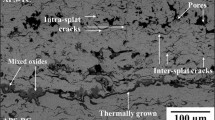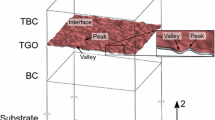Abstract
As a thermal barrier coating (TBC) is exposed to elevated temperatures, oxidation proceeds at the interface between the top coat of the TBC and the bond coat/substrate. This aluminium-rich layer, in the case of the TBC studied in this work, produces an alumina thermally grown oxide (TGO) at the interface. This layer continues to grow as the exposure time increases and is prone to cracking. Failure of the TGO creates a debond which will affect the heat transfer through the system and lead to localised overheating. Samples of an IN6203DS substrate with a CoNiCrAlY bond coat and YSZ top coat have been thermally aged and a selection of these used to determine the morphology of cracking within the TGO. This quantitative information has subsequently been used to determine the effect on the heat transfer performance of the TBC system using a process of inverse modelling.








Similar content being viewed by others
References
R. Harrabin, “Clean electricity overtaking fossil fuels in Britain,” BBC News, 21 June 2019. [Online]. Available: https://www.bbc.co.uk/news/science-environment-48711649. [Accessed 14 October 2019].
M. P. Boyce, Gas turbine engineering handbook, 3rd ed (Gulf professional publishing, Boston, 2008),.
N. Birks, G. H. Meier and F. S. Pettit, Introduction to the high-temperature oxidation of metals (Second edition), Cambridge: Cambridge University Press.
R. Taylor, J. R. Brandon, and P. Morell, Surface and Coatings Technology 50, 141 (1991).
F. Wu, E. H. Jordan, X. Ma, and M. Gell, Surface and Coatings Technology 202, 1628 (2008).
M. Seraffon, N. J. Simms, J. R. Nicholls, J. Sumner, and J. Nunn, Materials at High Temperature 4, 309 (2011).
M. Patel, H. Jones, A. T. Fry, M. A. Baker and J. F. Watts, “Micro mechanical testing of aged thermal barrier coatings,” in High Temperature Corrosion and Protection of Materials 2020, In Press, 2021.
L. Wright, A. Farooqui, J. Wu, R. Morrell, M. J. Pekris and M. J. Whiting, “Sensitivity Studies of Evaluating Partial De-Bonding Using Laser Flash Method,” In 34th International Thermal Conductivity Conference (ITCC), Delaware, USA, 2019
D. Lowe, International Journal of Computer Vision 60, 2004 (91).
P. S. Liao, T. S. Chen, and P. C. Chung, Journal of Information Science and Engineering 17, 713 (2001).
L. Wright, X. S. Yang, C. Matthews, L. Chapman, and S. Roberts, Studies in Computational Intelligence 359, 205 (2011).
P. N. Quested, R. F. Brooks, L. Chapman, R. Morrell, Y. Youssef, and K. C. Mills, Materials Science and Technolohy 25, 154 (2013).
K. Jiang, S. Liu, and X. Wang, Ceramics International 40, 12633 (2017).
“qedfusion.org,” [Online]. Available: http://qedfusion.org/LIB/PROPS/PANOS/al2o3.html. [Accessed October 2020].
L. A. Chapman, A. T. Fry, and S. J. Roberts, NPL Report DEPC-MPE 018: thermal diffusivity and thermal conducivity measurements on oxide scales, (National Physical Laboratory, London, 2005).
M. Seraffon, “Performances of air plasma sprayed thermal barrier coatings for industrial gas turbines, PhD Thesis,” Cranfield University, Cranfield, 2012.
H. Echsler, V. Shemet, M. Schutze, L. Singheiser, and W. J. Quadakkers, Journal of Materials Science 41, 1047 (2006).
J. G. Sun, A. Kulkarni and A. T. Fry, Materials at High Temperatures, 202
Acknowledgements
This research is funded by the Engineering & Physical Sciences Research Council (EPSRC) (award no EP/G037388). The authors would like to acknowledge the support received from the colleagues at the National Physical Laboratory (NPL) and the Microstructural Studies Unit (MSSU) at the University of Surrey.
Author information
Authors and Affiliations
Corresponding author
Ethics declarations
Conflicts of interest
There are no conflicts of interest or competing interests.
Availability of data and material
Data are available through the National Physical Laboratory, please contact main author to request.
Code availability
This will be available through the Ph.D. thesis of Ateeb Farooqui.
Additional information
Publisher's Note
Springer Nature remains neutral with regard to jurisdictional claims in published maps and institutional affiliations.
Rights and permissions
About this article
Cite this article
Fry, A.T., Patel, M., Gorman, D. et al. The Effect of Cracking of Thermally Grown Oxide Layers in Thermal Barrier Coatings Examined Using FIB Tomography and Inverse Modelling. Oxid Met 96, 157–168 (2021). https://doi.org/10.1007/s11085-021-10074-3
Received:
Revised:
Accepted:
Published:
Issue Date:
DOI: https://doi.org/10.1007/s11085-021-10074-3




